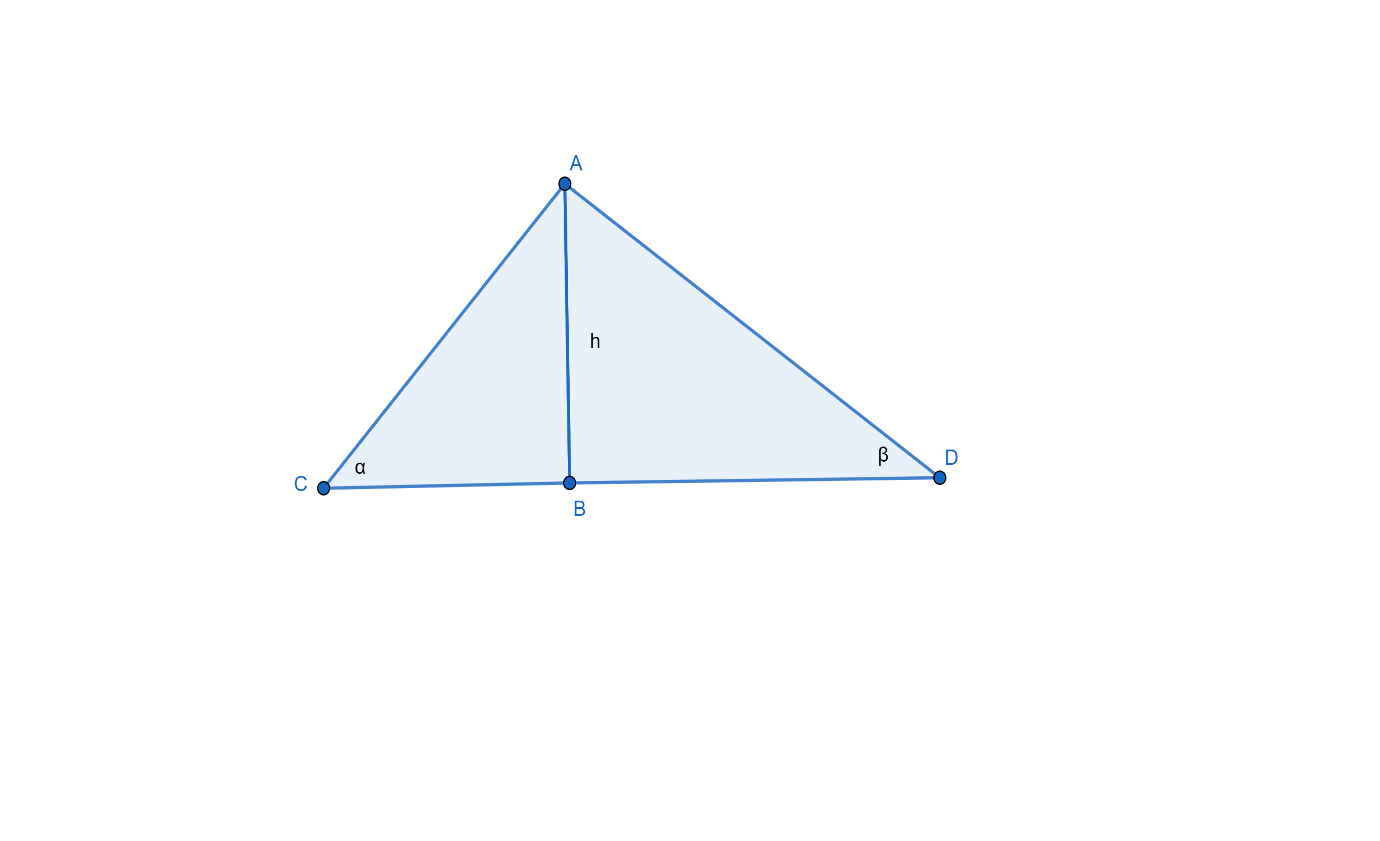Answer
413.7k+ views
Hint: First we will draw the figure and mark all the values that are given so that we can get a clear picture of what we need to find, then we will use the formula $\tan \alpha =\dfrac{height}{base}$ and substitute the value of height as h and find the value of base for the two triangles and then add them to get the final answer.
Complete step-by-step answer:
Let’s first draw the figure,

In the above figure,
AB = h = height of the light house
DC = distance between the two ships
To find the value DC we need to find the value of BD and BC,
Let’s first find the value of DB,
In triangle ABD, height = AB = h and base = DB
$\tan \beta =\dfrac{height}{base}$
Now substituting the value of height = h and base = DB we get,
$\begin{align}
& \tan \beta =\dfrac{h}{DB} \\
& DB=\dfrac{h}{\tan \beta }...........(1) \\
\end{align}$
Let’s find the value BC,
In triangle ABC, height = AB = h and base = BC
$\tan \alpha =\dfrac{height}{base}$
Now substituting the value of height = h and base = BC we get,
$\begin{align}
& \tan \alpha =\dfrac{h}{BC} \\
& BC=\dfrac{h}{\tan \alpha }...........(2) \\
\end{align}$
Now we know that,
DC = DB + BC
Substituting the values of DB and BC from equation (1) and (2) we get,
$\begin{align}
& DC=\dfrac{h}{\tan \alpha }+\dfrac{h}{\tan \beta } \\
& DC=\dfrac{h\left( \tan \alpha +\tan \beta \right)}{\tan \alpha \tan \beta } \\
\end{align}$
Hence Proved.
Note: To check if the statement that we have proved is true or not, one can put the values of all the variables and check if DC = $\dfrac{h\left( \tan \alpha +\tan \beta \right)}{\tan \alpha \tan \beta }$ is true or not. Students must be able to understand the meaning of the question to solve it correctly.
Complete step-by-step answer:
Let’s first draw the figure,

In the above figure,
AB = h = height of the light house
DC = distance between the two ships
To find the value DC we need to find the value of BD and BC,
Let’s first find the value of DB,
In triangle ABD, height = AB = h and base = DB
$\tan \beta =\dfrac{height}{base}$
Now substituting the value of height = h and base = DB we get,
$\begin{align}
& \tan \beta =\dfrac{h}{DB} \\
& DB=\dfrac{h}{\tan \beta }...........(1) \\
\end{align}$
Let’s find the value BC,
In triangle ABC, height = AB = h and base = BC
$\tan \alpha =\dfrac{height}{base}$
Now substituting the value of height = h and base = BC we get,
$\begin{align}
& \tan \alpha =\dfrac{h}{BC} \\
& BC=\dfrac{h}{\tan \alpha }...........(2) \\
\end{align}$
Now we know that,
DC = DB + BC
Substituting the values of DB and BC from equation (1) and (2) we get,
$\begin{align}
& DC=\dfrac{h}{\tan \alpha }+\dfrac{h}{\tan \beta } \\
& DC=\dfrac{h\left( \tan \alpha +\tan \beta \right)}{\tan \alpha \tan \beta } \\
\end{align}$
Hence Proved.
Note: To check if the statement that we have proved is true or not, one can put the values of all the variables and check if DC = $\dfrac{h\left( \tan \alpha +\tan \beta \right)}{\tan \alpha \tan \beta }$ is true or not. Students must be able to understand the meaning of the question to solve it correctly.
Recently Updated Pages
Three beakers labelled as A B and C each containing 25 mL of water were taken A small amount of NaOH anhydrous CuSO4 and NaCl were added to the beakers A B and C respectively It was observed that there was an increase in the temperature of the solutions contained in beakers A and B whereas in case of beaker C the temperature of the solution falls Which one of the following statements isarecorrect i In beakers A and B exothermic process has occurred ii In beakers A and B endothermic process has occurred iii In beaker C exothermic process has occurred iv In beaker C endothermic process has occurred

The branch of science which deals with nature and natural class 10 physics CBSE

The Equation xxx + 2 is Satisfied when x is Equal to Class 10 Maths

Define absolute refractive index of a medium

Find out what do the algal bloom and redtides sign class 10 biology CBSE

Prove that the function fleft x right xn is continuous class 12 maths CBSE

Trending doubts
Difference between Prokaryotic cell and Eukaryotic class 11 biology CBSE

Fill the blanks with the suitable prepositions 1 The class 9 english CBSE

Two charges are placed at a certain distance apart class 12 physics CBSE

Difference Between Plant Cell and Animal Cell

What organs are located on the left side of your body class 11 biology CBSE

Change the following sentences into negative and interrogative class 10 english CBSE

The planet nearest to earth is A Mercury B Venus C class 6 social science CBSE

The Equation xxx + 2 is Satisfied when x is Equal to Class 10 Maths

What is BLO What is the full form of BLO class 8 social science CBSE



